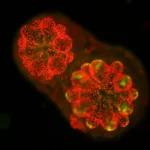(Press-News.org) Scientists have discovered the gene that enables marine algae to make a unique type of chlorophyll. They successfully implanted this gene in a land plant, paving the way for better crop yields on less land.
Finding the gene solves a long-standing mystery amongst scientists about the molecular pathways that allow the algae to manufacture this chlorophyll and survive.
“Marine algae produce half of all the oxygen we breathe, even more than plants on land. And they feed huge food webs, fish that get eaten by mammals and humans,” said UC Riverside assistant professor of bioengineering and lead study author Tingting Xiang. “Despite their global significance, we did not understand the genetic basis for the algae’s survival, until now.”
The study, published in Current Biology, also documents another first-of-its-kind achievement: demonstrating that a land plant could produce the marine chlorophyll. Tobacco plants were used for this experiment, but in theory, any land plant may be able to incorporate the marine algae gene, allowing them to absorb a fuller spectrum of light and achieve better growth.
Chlorophyll is a pigment that enables photosynthesis, the process of converting light into “food,” or chemical energy. Plants produce chlorophyll a and b, while most marine algae and kelp produce c, which enables them to absorb the blue-green light that reaches the water.
“Chlorophylls b and c absorb light at different wavelengths,” said Xiang. “The ocean absorbs red light, which is why it looks blue. Chlorophyll c evolved to capture the blue-green light that penetrates deeper into the water.”
An additional application of this research could be in the production of algae biofuels. There are a few algae species that produce chlorophylls a or b like land plants, instead of c. Imbuing those algae with the gene to make chlorophyll c could also enhance their ability to use more light and increase their growth, creating more feedstock for the fuels.
The researchers initially set out to gain insight into an algae species that lives in coral. These algae manufacture sugars and share them with their coral hosts. “Each coral colony has thousands of polyps, and their brown color is from the algae. Whenever you see coral bleaching, it’s due to the loss of the algae,” Xiang said.
Interested in how the algae’s ability to do photosynthesis would affect the coral, the researchers worked with mutant algae as an experiment. These rare mutants were more yellow in color than their brown relatives and were unable to perform photosynthesis. They found, unexpectedly, that in coral, these mutant algae were still able to live and grow because the coral gives the algae sustenance to grow.
As luck would have it, by using next-generation DNA sequencing and a lot of data analysis, the researchers were also able to use the mutants to discover the gene responsible for chlorophyll c production. “Discovering the chlorophyll c gene was not the initial goal of our work. We made the mutants for another reason, but I guess we were just lucky,” Xiang said.
With new insight into the genetic basis for producing chlorophyll c, the researchers are hopeful that the work could eventually help stem the tide of coral bleaching seen worldwide. Furthermore, there are land-based applications that could help people adapt to climate change.
"The identification of the biosynthetic pathway for chlorophyll c is more than a scientific curiosity; it's a potential game-changer for sustainable energy and food security,” said Robert Jinkerson, UCR chemical engineering professor and study co-author.
“By unlocking the secrets of this key pigment, we're not only gaining insights into the lifeblood of marine ecosystems but also pioneering a path towards developing more robust crops and efficient biofuels,” Jinkerson said.
END
Marine algae implants could boost crop yields
Discovery could lead to more sustainable food supply
2024-03-06
ELSE PRESS RELEASES FROM THIS DATE:
Model estimates who benefits most from frequent COVID-19 boosters
2024-03-06
Patients kept asking a question that Nathan Lo, MD, PhD, infectious disease specialist, had a hard time answering: How often should I get my booster shot for COVID-19?
“It’s a question that we have all asked. My patients have asked; friends and family members have asked,” Lo said. “We point to the national vaccine recommendations, although increasingly this question has become challenging to answer. I didn’t quite have the estimates on hand that I might hope to share with patients.”
To build that evidence, Lo and his team at Stanford ...
XPANCEO and Nobel laureate unveil the new properties discovery in graphene-like materials, transforming healthcare, AI and AR
2024-03-06
XPANCEO, a deep tech company developing the first smart contact lenses with XR vision, health monitoring, and content surfing features, in collaboration with the Nobel laureate Konstantin S. Novoselov (National University of Singapore, University of Manchester) and professor Luis Martin-Moreno (Instituto de Nanociencia y Materiales de Aragon), has announced in Nature Communications a groundbreaking discovery of new properties of rhenium diselenide and rhenium disulfide, enabling novel mode of light-matter interaction with huge potential for integrated photonics, healthcare, and AR. Rhenium disulfide ...
More than half of American Indian youth may have abnormal or high cholesterol
2024-03-06
More than 70% of American Indian young adults aged 20-39 and 50% of American Indian teens have cholesterol levels or elevated fat in the blood that put them at risk for cardiovascular disease, suggests a study supported by the National Institutes of Health. In some cases, these levels — specifically high low-density lipoprotein (LDL) cholesterol, often thought of as “bad cholesterol,” — were linked to plaque buildup and cardiovascular events, such as heart attack and stroke.
The findings, ...
How does wearing makeup affect skin during exercise?
2024-03-06
New research published in the Journal of Cosmetic Dermatology reveals the effects of wearing cosmetic foundation during aerobic exercise on the skin and its pores.
The study included 43 healthy college students (20 males and 23 females). Foundation cream was applied to participants on half of the face in two different areas (forehead and upper cheek). The other half of the face served as control.
Moisture increased after exercise in both the non-makeup and makeup zones; however, there was a greater increase in moisture in the makeup zones. This may be a result of makeup preventing ...
Can artificial intelligence–based systems spot hard-to-detect space debris?
2024-03-06
An increasing number of space objects, debris, and satellites in Low Earth Orbit poses a significant threat of collisions during space operations. The situation is currently monitored by radar and radio-telescopes that track space objects, but much of space debris is composed of very small metallic objects that are difficult to detect. In a study published in IET Radar, Sonar & Navigation, investigators demonstrate the benefits of using deep learning—a form of artificial intelligence—for small space object detection by ...
How does a diabetes drug lessen symptoms of depression?
2024-03-06
Research in animals has shown that the diabetes drug dulaglutide, which is a glucagon-like peptide-1 (GLP-1) receptor agonist may reduce symptoms of depression. A new study published in Brain and Behavior reveals the mechanisms that are likely involved.
By conducting a range of tests in mice treated with and without dulaglutide, investigators confirmed the effects of dulaglutide on depressive-like behaviors, and they identified 64 different metabolites and four major pathways in the brain associated with these effects.
Markers of depression and the antidepressant effects of dulaglutide were linked to lipid metabolism, amino acid metabolism, energy metabolism, ...
How do artificial intelligence programs fare in dermatology applications for people with diverse skin tones?
2024-03-06
Artificial intelligence (AI) programs have recently acquired widespread popularity in dermatology for assessing, diagnosing, and treating skin conditions. As reported in the International Journal of Dermatology, investigators recently analyzed all published studies from the last 10 years to evaluate current AI programs in use for dermatologic purposes, uncovering significant shortcomings when applied to skin of color (SOC).
The researchers identified various challenges when this technology is applied to SOC, ...
Has Medicaid expansion affected pregnancy outcomes among women with gestational diabetes?
2024-03-06
The Affordable Care Act (ACA) aims to broaden healthcare access, but its effect on maternal and newborn health among women with gestational diabetes—or diabetes that develops during pregnancy—across diverse demographics is unclear. In a study published in the International Journal of Gynecology & Obstetrics, researchers compared the impact of the implementation of the ACA on maternal and newborn health in Maryland (with ACA implementation) and Georgia (without ACA implementation) among 52,479 women.
The investigators found that after ACA implementation, Maryland showed improved newborn outcomes compared ...
What are the trends and outcomes of anterior cruciate ligament injury treatments in children?
2024-03-06
Anterior cruciate ligament (ACL) injuries have increased in recent decades among children. Because re-injuries after ACL reconstruction are higher in children compared with adults, anterolateral augmentation procedures may reduce re-injury rates after ACL reconstruction in youth. A comprehensive review published in the Journal of Experimental Orthopaedics marks the first attempt to present the outcomes and surgical methods of anterolateral augmentation procedures for skeletally immature patients.
“We found many different surgical techniques ...
Gene discovered that can protect against severe muscle disease
2024-03-06
A specific gene may play a key role in new treatments that prevent muscle in the body from breaking down in serious muscle diseases, muscular dystrophies. This is shown in a new study at Umeå University, Sweden. Protein expressed by the gene naturally prevents the muscles around the eye from being affected when other muscles in the body are broken down during muscular dystrophies. In the study, the so-called genetic scissors were used and the gene is expressed in all muscles. The effects were that muscular dystrophin was alleviated throughout the body.
"You could say that the eye muscles function as both an eye-opener for understanding the disease and as a door ...
LAST 30 PRESS RELEASES:
Heart-brain connection: international study reveals the role of the vagus nerve in keeping the heart young
Researchers identify Rb1 as a predictive biomarker for a new therapeutic strategy in some breast cancers
Survey reveals ethical gaps slowing AI adoption in pediatric surgery
Stimulant ADHD medications work differently than thought
AI overestimates how smart people are, according to HSE economists
HSE researchers create genome-wide map of quadruplexes
Scientists boost cell "powerhouses" to burn more calories
Automatic label checking: The missing step in making reliable medical AI
Low daily alcohol intake linked to 50% heightened mouth cancer risk in India
American Meteorological Society announces Rick Spinrad as 2026 President-Elect
Biomass-based carbon capture spotlighted in newly released global climate webinar recording
Illuminating invisible nano pollutants: advanced bioimaging tracks the full journey of emerging nanoscale contaminants in living systems
How does age affect recovery from spinal cord injury?
Novel AI tool offers prognosis for patients with head and neck cancer
Fathers’ microplastic exposure tied to their children’s metabolic problems
Research validates laboratory model for studying high-grade serous ovarian cancer
SIR 2026 delivers transformative breakthroughs in minimally invasive medicine to improve patient care
Stem Cell Reports most downloaded papers of 2025 highlight the breadth and impact of stem cell research
Oxford-led study estimates NHS spends around 3% of its primary and secondary care budget on the health impacts of heat and cold in England
A researcher’s long quest leads to a smart composite breakthrough
Urban wild bees act as “microbial sensors” of city health.
New study finds where you live affects recovery after a hip fracture
Forecasting the impact of fully automated vehicle adoption on US road traffic injuries
Alcohol-related hospitalizations from 2016 to 2022
Semaglutide and hospitalizations in patients with obesity and established cardiovascular disease
Researchers ‘listen in’ to embryo-mother interactions during implantation using a culture system replicating the womb lining
How changing your diet could help save the world
How to make AI truly scalable and reliable for real-time traffic assignment?
Beyond fragmented markets: A new framework for efficient and stable ride-pooling
Can shape priors make road perception more reliable for autonomous driving?
[Press-News.org] Marine algae implants could boost crop yieldsDiscovery could lead to more sustainable food supply



